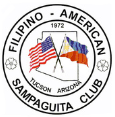Founded in 1972, the association was formally organized and elected its first president, Dr. Ben Ventura. Since then the agenda of activities expanded. Aside from playing mahjong, the members enjoyed monthly potlucks in the park, bowling, and Christmas caroling. Pista sa Nayon was also celebrated to commemorate Philippine Independence Day in June. There was music and folk dances aside from lumpia and pancit. There was no celebration without Tinikling and Pandango sa Ilao performed by both children and adults. There was always someone willing to take over the helmet of responsibility to ensure the continuity of the club, then named Sampaguita after the national flower of the Philippines.
The following past presidents dared to continue the leadership and made the club exist up to the present: Estela Freiberg, Fred Polintan, Jr., Pete Cano, Earl Osborn, Butch Marking, Dr. Roy Yap, Fred Polintan, Sr., Bill Mann, Ray de los Santos, Shiraz Peera, Rudy Ypulong, Dr. Greg Oswald, Dr. Cecilia Gomez Andersen, Susan Liang, Cynthia Hermann, Don Rodriguez, Esperanza Gutang, Lydia Peera, Carol Ypulong, Idabella Schroeder, Alice Polintan, Bing Contaoi, Neneng Babanto Fassler, Roger Narciso, Tom Trajano, Dr. Mennen Garcia, Joe Abong, Amie Gadigan, Amado Arietta, Imelda Cuyugan, Mark Schroeder, Marie A. Hanna, Chris O’Hara, Atty. Marylou Natividad, Ester Havey, and Dennis Maduli.
The club has associated with the Tucson Meet Yourself since its inception. It found its participation profitable and the idea of fundraising sunk in. The objective was adopted which is to create a building fund for a cultural building. The constitution took many years to be fully written. The club was finally registered with the Arizona Corporation Commission as a non-profit organization in 1980 and was named Filipino-American Sampaguita Club of Tucson (FASCOT).
The club has shed colors and changed names, but it still survived as the first Filipino non-profit organization in Tucson, Arizona. FASCOT has changed direction and is expanding its activities and services to the community at large. It is now going forward to become an entity with charitable and cultural design. Every year it gives scholarships to deserving young people who need help achieve college education. It also responds to call of humanitarian, civic, and social services. Projects and community services that include Adopt-A-Roadway, joining the Memory Walk with the Alzheimer’s Association, responding to world calamities, collaborating with other organization build homes for the homeless are but examples of the efforts of the members of this organization.
The club will continue to exist as long as there are devoted members and leaders willing to carry its responsibility of promoting our beautiful heritage to the community at large.
Back To Top
